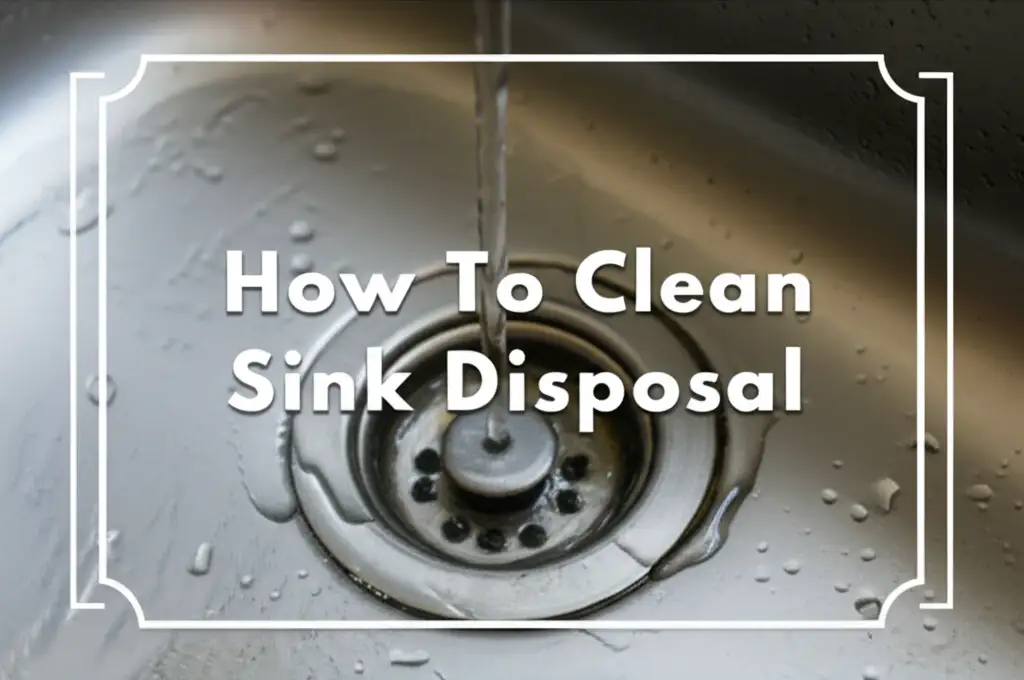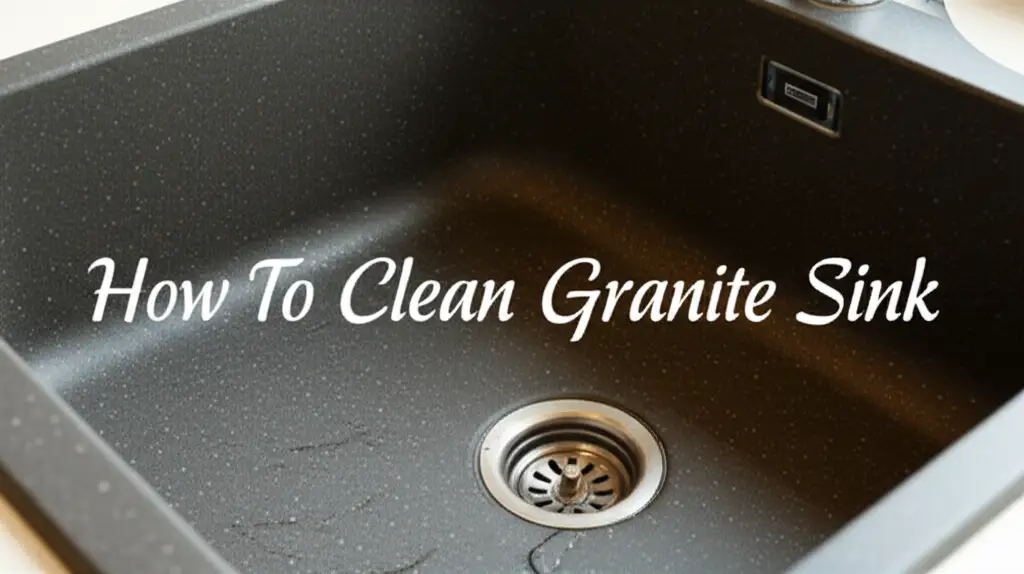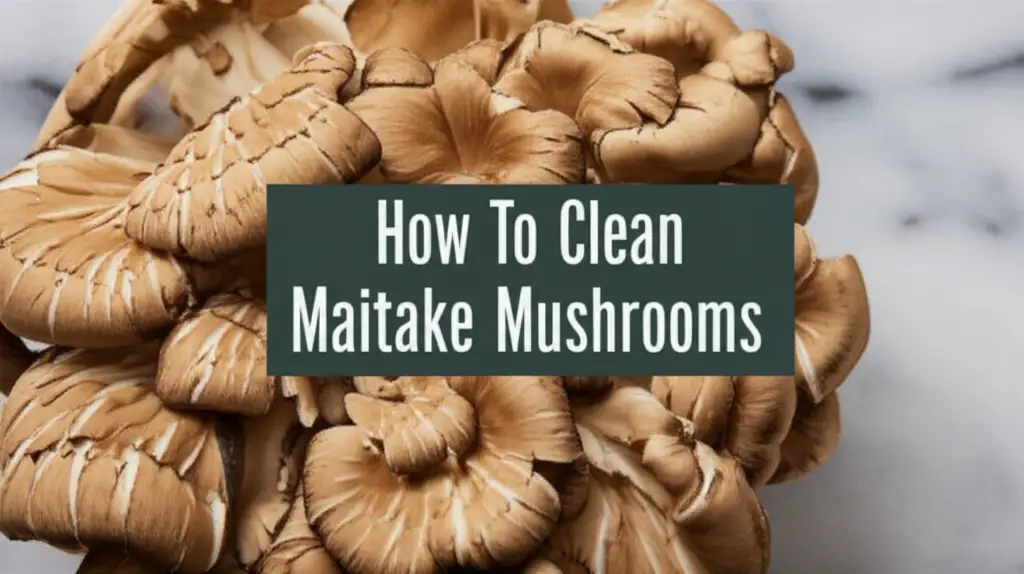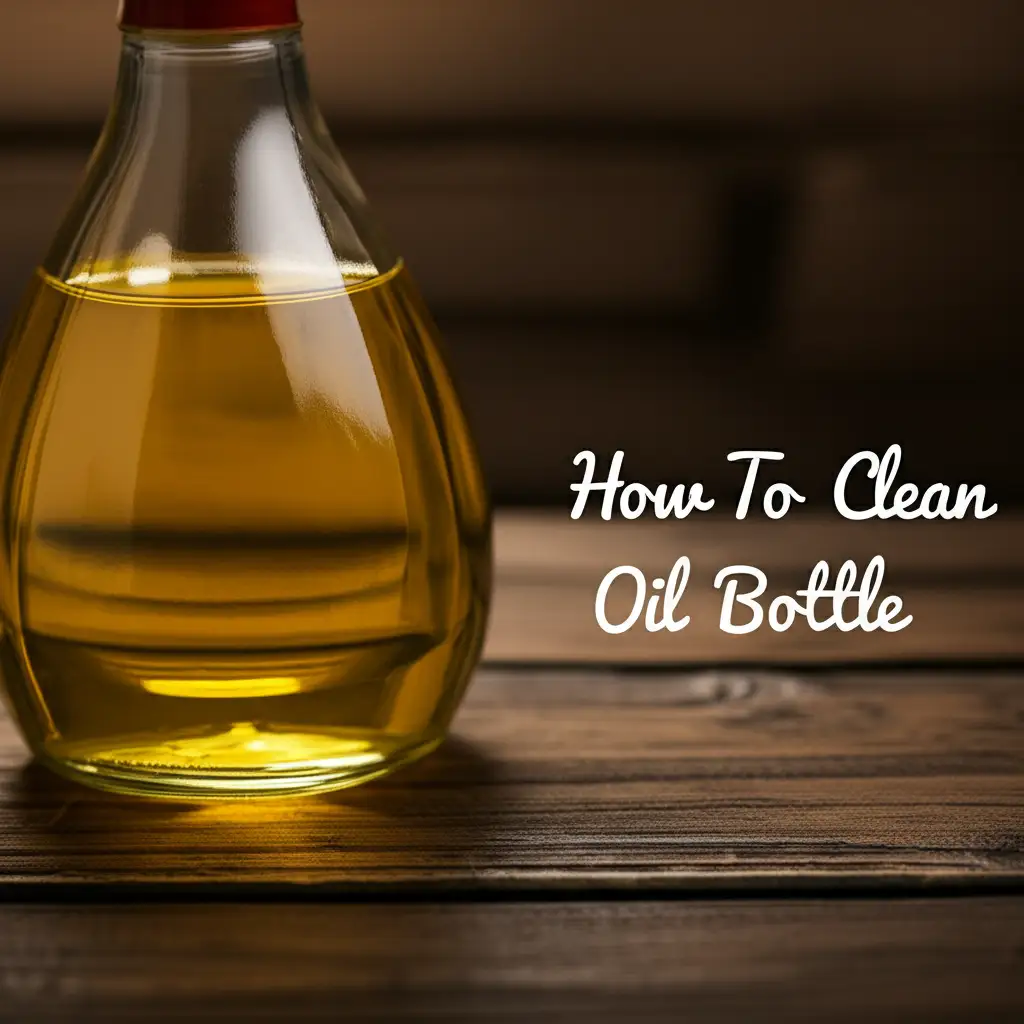· Kitchen Cleaning · 17 min read
How To Clean Sink Disposal

Master Your Kitchen: How To Clean Your Sink Disposal
A fresh kitchen starts with a clean sink. My kitchen sink disposal often produces unpleasant smells. These odors come from food particles stuck inside. Cleaning your sink disposal removes these particles. It makes your kitchen smell better. A clean disposal also works more efficiently.
This article will show you how to clean your sink disposal thoroughly. I will explain natural methods and deep cleaning steps. You will also learn maintenance tips. This helps keep your disposal fresh.
Takeaway
- Regularly clean your sink disposal to prevent odors.
- Use natural ingredients like ice, salt, citrus, baking soda, and vinegar.
- Always ensure safety by turning off power before deep cleaning.
- Maintain your disposal with consistent use and cold water.
- Address clogs or persistent issues promptly for optimal performance.
To effectively clean your sink disposal, combine abrasive agents like ice and salt with odor neutralizers such as baking soda and vinegar, followed by citrus peels for a fresh scent. Always ensure the disposal is off and unplugged before any physical cleaning to guarantee safety.
Why Cleaning Your Sink Disposal Matters
Your kitchen sink disposal handles daily food waste. Bits of food can cling to its blades and walls. These bits break down over time. This decay creates bad odors. A smelly disposal makes your whole kitchen unpleasant. I find this frustrating.
Cleaning your disposal prevents these smells. It removes the decaying food. This improves kitchen hygiene. A clean disposal also works better. Food processes smoothly. It reduces the chance of clogs. Clogs can stop your sink from draining. They cause a lot of trouble. Regular cleaning extends the disposal’s life. It prevents costly repairs. I always aim for a disposal that works well and smells fresh.
Understanding Odor Sources
Bad smells often come from rotting food. Small particles hide in the disposal. They stick to grinder components. Grease and grime also build up. This forms a sticky layer. Bacteria grow on this layer. These bacteria produce foul odors. The splash guard also collects residue. It becomes a breeding ground for smells. Cleaning targets these specific areas. It eliminates the source of the odor.
Preventing Clogs and Malfunctions
Food accumulation leads to clogs. These clogs block water flow. They prevent the disposal from grinding properly. Hard items can also jam the blades. Cleaning removes these potential blockers. It keeps the disposal clear. This helps prevent malfunctions. A well-maintained disposal operates smoothly. It handles food waste without issues. This ensures long-term performance.
Essential Tools and Safety First
Before you start cleaning your sink disposal, gather your tools. You need basic household items. Safety is the most important step. Always prioritize your well-being. I make sure to have everything ready. This prevents interruptions. It also ensures a safe cleaning process.
Gathering Your Cleaning Supplies
You do not need many special tools. Common kitchen items work well. Ice cubes are helpful. Rock salt or coarse salt also work. Baking soda is excellent for odors. White vinegar helps with grime and bacteria. Fresh citrus peels add a pleasant smell. A sturdy scrub brush with a long handle is good. You might also need a screwdriver. This helps for more serious cleaning tasks. I keep these items handy.
Here is a list of supplies:
- Ice cubes (about 2 cups)
- Coarse salt (1/2 cup) or rock salt
- Baking soda (1/2 cup)
- White vinegar (1 cup)
- Lemon, lime, or orange peels
- Dish soap
- Stiff scrub brush
- Gloves
- Flashlight (optional, for inspection)
- Screwdriver (for splash guard removal, if needed)
Prioritizing Safety Measures
Safety always comes first. This is especially true when working with appliances. Always turn off the power to your disposal. Do this at the circuit breaker. This prevents accidental activation. Accidental activation can cause severe injury. Never put your hand inside the disposal. Even when it is off, blades are sharp. Use gloves to protect your hands. I double-check the power is off every time.
Key Safety Steps:
- Turn off power: Locate your electrical panel. Find the breaker switch for your kitchen. Flip it to the “off” position. This stops power flow to the disposal unit.
- Verify power is off: Press the disposal switch. Confirm it does not turn on. This ensures no power reaches the unit.
- Wear gloves: Use sturdy rubber gloves. These protect your hands from grime. They also prevent contact with sharp edges.
- Never insert hands: Do not put your hand or fingers into the disposal. Use tongs or a long brush instead. This prevents injury from sharp parts.
By following these safety steps, you protect yourself. You can clean your disposal with peace of mind.
Natural Cleaning Methods for a Fresh Disposal
Natural ingredients offer effective ways to clean your sink disposal. They are safe for your pipes. They also do not contain harsh chemicals. I prefer these methods first. They often solve most common odor and grime issues. These methods use simple items you probably already have.
The Ice, Salt, and Citrus Blast
This method uses abrasives and fresh scents. Ice helps solidify grease. It also acts as a scouring agent. Salt provides extra scrubbing power. Citrus peels leave a pleasant smell. This combination cleans and freshens. It is a quick and effective routine. I use this method frequently for basic maintenance.
Follow these steps:
- Run cold water: Turn on your cold water faucet. Keep it running lightly. This helps flush the debris.
- Add ice and salt: Pour about two cups of ice into the disposal. Add half a cup of coarse salt. The ice and salt will grind against the disposal walls. They scrape off food particles and grime.
- Turn on disposal: Turn the disposal on for 30-60 seconds. Let it run until you hear the grinding stop. The noise level indicates its work.
- Add citrus peels: With the water still running, drop in a handful of citrus peels. Lemon, lime, or orange peels work best. The peels release fresh oils. These oils combat lingering odors. For more specific information on citrus cleaning, you can check out this guide on how to clean garbage disposal with lemon.
- Flush: Continue running cold water for 15-30 seconds after the peels are gone. This flushes all remaining debris down the drain.
This method effectively cleans the grinding chamber. It also helps sharpen the blades.
Baking Soda and Vinegar: The Power Duo
Baking soda and vinegar create a fizzing action. This reaction helps break down grime. It also neutralizes odors. This method is excellent for deodorizing. It works well on persistent smells. I use this combo for a deeper natural clean. It is safe and powerful.
Here is how to use them:
- Pour baking soda: Sprinkle half a cup of baking soda into the disposal. Make sure it goes down the drain opening. Baking soda absorbs odors. It also helps loosen food particles.
- Add vinegar: Pour one cup of white vinegar over the baking soda. The mixture will fizz and bubble. This reaction helps scrub the disposal. It also sanitizes the area.
- Let it sit: Let the mixture sit for 10-15 minutes. The longer it sits, the more it works. This allows the fizzing action to dissolve grime.
- Flush with hot water: After waiting, turn on the hot water faucet. Run it for about 30 seconds. The hot water rinses away the mixture. It also flushes loosened debris. For more details on using this specific method, refer to the article on how to clean disposal with baking soda.
This method provides a thorough cleaning. It leaves your disposal smelling fresh. This combination is a go-to for many cleaning tasks.
Deep Cleaning Stubborn Odors and Grime
Sometimes, natural methods are not enough. Stubborn odors and heavy grime need a deeper clean. This involves a bit more effort. It targets areas natural methods cannot reach directly. I recommend this deep cleaning approach when smells persist. It tackles the source of the worst odors.
Cleaning the Splash Guard and Underneath
The splash guard is a key area for grime build-up. It is the rubber flange at the top of the disposal opening. Food particles often stick to its underside. These particles rot and cause strong odors. The area under the sink can also accumulate grime or mold if there are leaks. If you suspect mold, an article on how to clean mold under sink can provide additional guidance.
Follow these steps for a thorough splash guard clean:
- Turn off power: Always begin by turning off the disposal’s power at the circuit breaker. This is crucial for safety.
- Inspect the splash guard: Look at the top side of the splash guard. You will see black grime.
- Lift and clean: Carefully lift each flap of the splash guard. Use a paper towel or an old cloth to wipe away visible grime. You might be surprised by how much is there.
- Remove splash guard (optional): For very stubborn grime, remove the splash guard. It usually pulls out. Some models require a screwdriver. Once removed, scrub it with dish soap and a stiff brush. Clean both sides thoroughly. Rinse it well.
- Clean inside the opening: Use a long-handled scrub brush. Clean the visible parts inside the disposal opening. Scrub the walls of the grinding chamber. Use dish soap and hot water. This removes stuck-on food.
- Reinstall splash guard: If you removed it, reinsert the splash guard. Ensure it fits snugly.
- Flush: Turn the power back on. Run cold water and the disposal for a few seconds. This flushes any loosened debris.
This focused cleaning on the splash guard makes a big difference. It removes a major source of bad smells.
Using Commercial Disposal Cleaners (Optional)
Commercial disposal cleaners are an option. They come in various forms. Some are foaming packets. Others are liquid solutions. These products often contain strong enzymes. Enzymes break down grease and food waste. They target heavy build-up. I use them sparingly. They are good for very difficult cases. Always read the product instructions carefully. Follow all safety warnings.
How to use commercial cleaners:
- Read instructions: Each product has specific directions. Follow them precisely.
- Prepare disposal: Typically, you run some water first.
- Add cleaner: Drop a packet or pour the liquid into the disposal.
- Wait: Allow the cleaner to work. This usually takes 15-30 minutes.
- Flush: Run water for the recommended time to rinse.
While effective, these cleaners are not always necessary. Natural methods are often enough. Natural solutions are also more environmentally friendly.
Troubleshooting Common Disposal Issues
Even with regular cleaning, issues can arise. Understanding common problems helps you fix them. The most frequent issues are clogs and persistent odors. Addressing these quickly keeps your disposal running well. I have faced these problems myself. Knowing how to troubleshoot saves time and money.
Dealing with Stubborn Clogs
A disposal clog stops water drainage. It can happen even in a clean disposal. Common causes include fibrous foods or too much food at once. Sometimes, items fall in accidentally. You must address clogs safely. Never reach into the disposal with your hand.
Steps to clear a clog:
- Turn off power: Go to your electrical panel. Turn off the circuit breaker for the disposal. Safety is paramount.
- Inspect visually: Use a flashlight. Look inside the disposal opening. See if you spot any obvious items. This could be a spoon or a piece of food.
- Remove obstruction: Use tongs or pliers. Carefully remove any visible object. Do not force it.
- Check reset button: If no object is visible, check the reset button. It is usually red. It is on the bottom of the disposal unit. Press it firmly. If it pops out, it means the motor overheated or jammed.
- Run cold water and disposal: Turn the power back on. Run cold water. Turn on the disposal. If it hums but does not grind, it is still jammed.
- Use an Allen wrench: Look for a hexagonal hole on the very bottom of the disposal. Insert the Allen wrench that came with your disposal (or a 1/4-inch wrench). Turn it back and forth. This manually frees the motor.
- Repeat reset and run: After freeing the motor, press the reset button again. Turn on the water and disposal.
If the clog persists, it might be in the P-trap or further down the drain. For general disposal issues, the guide on how to clean garbage disposal offers more insights.
Eliminating Persistent Odors
Persistent odors indicate a deeper issue. Food buildup is still present. It might be in areas difficult to reach. Or, it could be a sign of poor draining. This allows food particles to sit.
Advanced odor removal strategies:
- Boiling water flush: After other cleaning methods, pour a kettle of boiling water down the drain. Be cautious. This helps dislodge grease and particles. Do this only if your pipes are metal. Avoid if you have PVC pipes. Hot water can damage PVC.
- Deep scrub: Use a stiff, long-handled brush. Get deep into the disposal chamber. Scrub the sides and the top of the grinding plate. Use dish soap for extra cleaning power.
- Drain cleaner (very sparingly): As a last resort, use an enzyme-based drain cleaner. Do not use chemical drain cleaners designed for clogs. These can harm your disposal. Enzyme cleaners break down organic matter. Follow instructions exactly.
- Professional help: If odors remain after all these steps, consider professional help. A plumber can inspect your drain lines. They can also check for damage to the disposal itself. For more detailed solutions for smells, see how to clean smelly garbage disposal.
Addressing persistent odors requires patience. It often means combining several cleaning techniques.
Maintenance Tips for a Fresh Disposal
Cleaning your sink disposal is important. However, regular maintenance prevents future problems. Good habits keep your disposal fresh. They extend its lifespan significantly. I always follow these tips. They make cleaning less frequent.
Consistent Usage and Cold Water
Using your disposal regularly helps. It keeps the components moving. This prevents rust or stiffness. Always use cold water when running the disposal. Cold water solidifies grease. This allows the disposal to chop it into small pieces. Hot water melts grease. Melted grease can stick to pipes. It causes clogs in the drain line.
Best practices for daily use:
- Run disposal often: Grind small amounts of food frequently. Do not let food sit in the sink drain.
- Use cold water: Turn on cold water before activating the disposal. Keep it running for 15-30 seconds after turning the disposal off. This flushes all food particles.
- Feed slowly: Add food waste gradually. Do not cram large amounts at once. This prevents jams.
- Small pieces: Break down large food scraps into smaller pieces. This makes grinding easier.
What NOT to Put Down Your Disposal
Many items should never go into your disposal. These items can cause clogs or damage. Knowing what to avoid is crucial. It protects your appliance and plumbing.
Items to avoid:
- Grease, fats, and oils: These solidify in pipes. They cause severe clogs. Dispose of them in the trash.
- Fibrous foods: Celery stalks, corn husks, onion skins, and artichokes have tough fibers. They can tangle around blades.
- Starchy foods: Pasta, rice, and potato peels expand with water. They create a sticky paste. This can block pipes.
- Coffee grounds: These seem small. However, they accumulate into a sludgy, dense mass. This creates stubborn clogs.
- Eggshells: The membrane inside eggshells can stick to blades. They can also create gritty residue.
- Hard items: Fruit pits, bones, and nutshells are too hard. They dull blades or jam the motor.
- Non-food items: Plastic, metal, glass, and cleaning chemicals should never enter the disposal.
By avoiding these items, you reduce strain on your disposal. You also prevent costly repairs. This simple habit keeps your disposal healthy.
When to Call a Professional
Most disposal issues you can handle yourself. However, some problems need a professional plumber. Knowing when to call an expert saves time and prevents further damage. I understand that some tasks are best left to licensed individuals.
Persistent Clogs or Leaks
If a clog does not clear after troubleshooting, it is a big problem. This means the obstruction is severe. It might be deep in your plumbing system. DIY attempts could worsen the situation. A plumber has specialized tools. They can diagnose and remove tough clogs safely.
Leaks also signal a serious issue. Water leaking from your disposal means a seal is broken. Or, the housing might be cracked. Leaks can cause water damage. They also encourage mold growth. This is especially true under the sink. A plumber can identify the source of the leak. They can repair or replace the damaged part. Do not ignore leaks.
Signs you need a plumber:
- Water not draining: Even after using an Allen wrench and reset button.
- Water leaking: Visible drips or puddles under the sink near the disposal.
- Grinding noise, no action: The motor hums, but nothing grinds, and the Allen wrench does not help.
- Disposal not turning on: After checking the breaker and reset button, the unit is still dead.
Unusual Noises or Malfunctions
Disposals make a specific grinding noise. Any unusual sounds are a red flag. These could be loud clanking, high-pitched squealing, or grinding that sounds like metal on metal. These noises indicate a problem with the motor or blades. A foreign object might be stuck. Or, the internal components are damaged.
A professional can diagnose these noises. They can identify worn-out parts. They can also remove deeply lodged objects. Trying to fix complex internal issues yourself can be dangerous. It can also void your warranty. Plumbers have the expertise to handle these situations. They ensure your disposal runs safely. They can also replace the unit if necessary.
FAQ Section
How often should I clean my sink disposal?
You should clean your sink disposal weekly with ice and citrus for freshness. A baking soda and vinegar treatment works well monthly for deeper cleaning. Perform a full deep clean, including the splash guard, every three months to prevent stubborn grime and odors from building up.
Can I use bleach or chemical drain cleaners in my disposal?
No, do not use bleach or harsh chemical drain cleaners in your sink disposal. Bleach can corrode metal parts over time. Chemical drain cleaners can damage rubber seals and plastic components. These substances also pose a risk to your plumbing system. Stick to natural methods or enzyme-based cleaners for safety.
What should I do if my disposal smells bad even after cleaning?
If your disposal still smells after cleaning, the odor source might be deeper. Check the P-trap under the sink for trapped food. You might also have stubborn grease buildup in the drain line. Consider a professional plumber if the smell persists, as they can perform a thorough inspection or hydro-jetting.
How do I prevent my disposal from getting clogged?
Prevent clogs by running cold water for 15 seconds before and after using the disposal. Avoid putting fibrous foods, grease, coffee grounds, eggshells, or large bones down the drain. Feed food waste slowly and in small batches. Always break large food scraps into smaller pieces before grinding.
Is it normal for my disposal to hum but not grind?
A humming noise without grinding indicates a jammed motor. First, turn off the power at the circuit breaker. Look for the red reset button on the bottom of the disposal and push it. If it still hums, insert an Allen wrench into the center hole on the bottom of the unit and turn it back and forth to free the impellers.
Can I sharpen my disposal blades?
Disposal blades are not designed to be sharpened. They are technically impellers, not sharp blades. They work by grinding food against a shredder ring. Running ice cubes and coarse salt through the disposal helps scour away buildup on these impellers. This makes them more effective, but it does not sharpen them like a knife.
Conclusion
Keeping your sink disposal clean is a simple task with big rewards. A clean disposal means a fresh-smelling kitchen. It also ensures efficient operation. You can prevent frustrating clogs and costly repairs. I believe a healthy disposal contributes to a happy home.
Remember to use natural methods first. Ice, salt, citrus, baking soda, and vinegar are powerful tools. Prioritize safety by turning off power before any deep cleaning. Regular maintenance habits also make a huge difference. Avoid putting harmful items down the drain. This keeps your disposal working its best. If problems persist, do not hesitate to call a professional. Take action today. Implement these simple steps. Enjoy a cleaner, fresher kitchen. Make cleaning your sink disposal a routine. It is an important part of home care.
- garbage disposal cleaning
- smelly disposal
- kitchen sink maintenance




